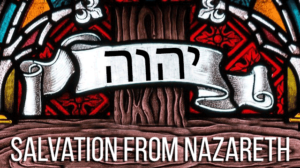 Salvation From Nazareth
Salvation From Nazareth
You have probably noticed an acronym popularly used on paintings, films and artistic depictions of the crucifixion of Yeshua. This acronym is usually posted as a sign that says INRI and is located above the cross. But what does it mean? Is it a proper and complete translation? Learn about it’s deeper meaning and the implications to the perception of the Savior’s identity.
The Sign
The Gospel of John specifies what was written in Hebrew as “Yeshua from Nazareth, King of the Jews”. The Latin translation “Iesus Nazarenus Rex Iudaeorum” is where the INRI initials came from. – An unfortunate mistranslation that hides away a deeper meaning as recorded by the Gospel writer in Hebrew, Latin and Greek.
“Pilate also had a notice written and posted on the stake; it read,
YESHUA FROM NATZERET
THE KING OF THE JEWS
Many of the Judeans read this notice, because the place where Yeshua was put on the stake was close to the city; and it had been written in Hebrew, in Latin and in Greek.”
John 19:19
The Culture
The Romans often attached a sign above those they crucified to identify the name of the person crucified, their crime and the charge. In this case, “Yeshua from Nazareth” specified who he was and where he was from, and “King of the Jews” specified the crime and charge of “claiming” to be a king.
Interesting enough, the title “King of the Jews” in the New Testament, was only used by gentiles, namely by the Magi, Pontius Pilate, and the Roman soldiers.
The True Meaning
Presented as “Yeshua from Nazareth”, or equally translated: “Salvation from Nazareth” or “YHWH Saves from Nazareth“, gives meaning and description to His identity and purpose. Making this distinction is important as it contains the notice to the word of Whom we are referring to, namely: The Savior of all who call on His name.
“he humbled himself still more by becoming obedient even to death — death on a stake as a criminal!
Therefore God raised him to the highest place and gave him the name above every name;”Philippians 2:8-9
Another Mystery Reviewed
In Hebrew, the words Yeshua from Nazareth, King of the Jews translates to ישוע הנצרתי ומלך היהודים composing the acronym יהוה (YHWH), the holiest name in Scripture.
ישוע הנצרתי ומלך היהודים
Going Deeper
The Gospel of John recorded Yeshua alluding to himself as “I AM”, which is the divine name of the God of Abraham, and the name used when He reviewed Himself to Moses.
“So Yeshua said, “When you lift up the Son of Man, then you will know that I AM [who I say I am], and that of myself I do nothing, but say only what the Father has taught me.”
John 8:28
God said to Moses, “Ehyeh Asher Ehyeh [I am/will be what I am/will be],” and added, “Here is what to say to the people of Isra’el: ‘Ehyeh [I Am or I Will Be] has sent me to you.’”
Exodus 3:14
The words that compose “I AM” have something in common; the Hebrew root HYH (היה), meaning “to be”. This is a reiteration of who Yeshua was, is and is to come.
Conclusion
Yeshua clearly presented Himself as both the Messiah and the Great I AM when He used words that composed and reviewed the Hebrew name of the Father. It is probable that only the Hebrews that read Pilates’ sign could understand the reference to Yeshua’s divinity and the meaning lost in translation to Latin and Greek.
Unfortunately, the de-Jewification of Messiah’s name, combined with culture influences and traditions, have hidden important meanings and messages we need to learn.
Setting aside the cultural pressures and what we have been taught is important as we embrace the essence of what is written and study for ourselves under the guidance of the Holy Spirit. The LORD wants to review Himself to us.
Shalom!
Rabbi Douglas
